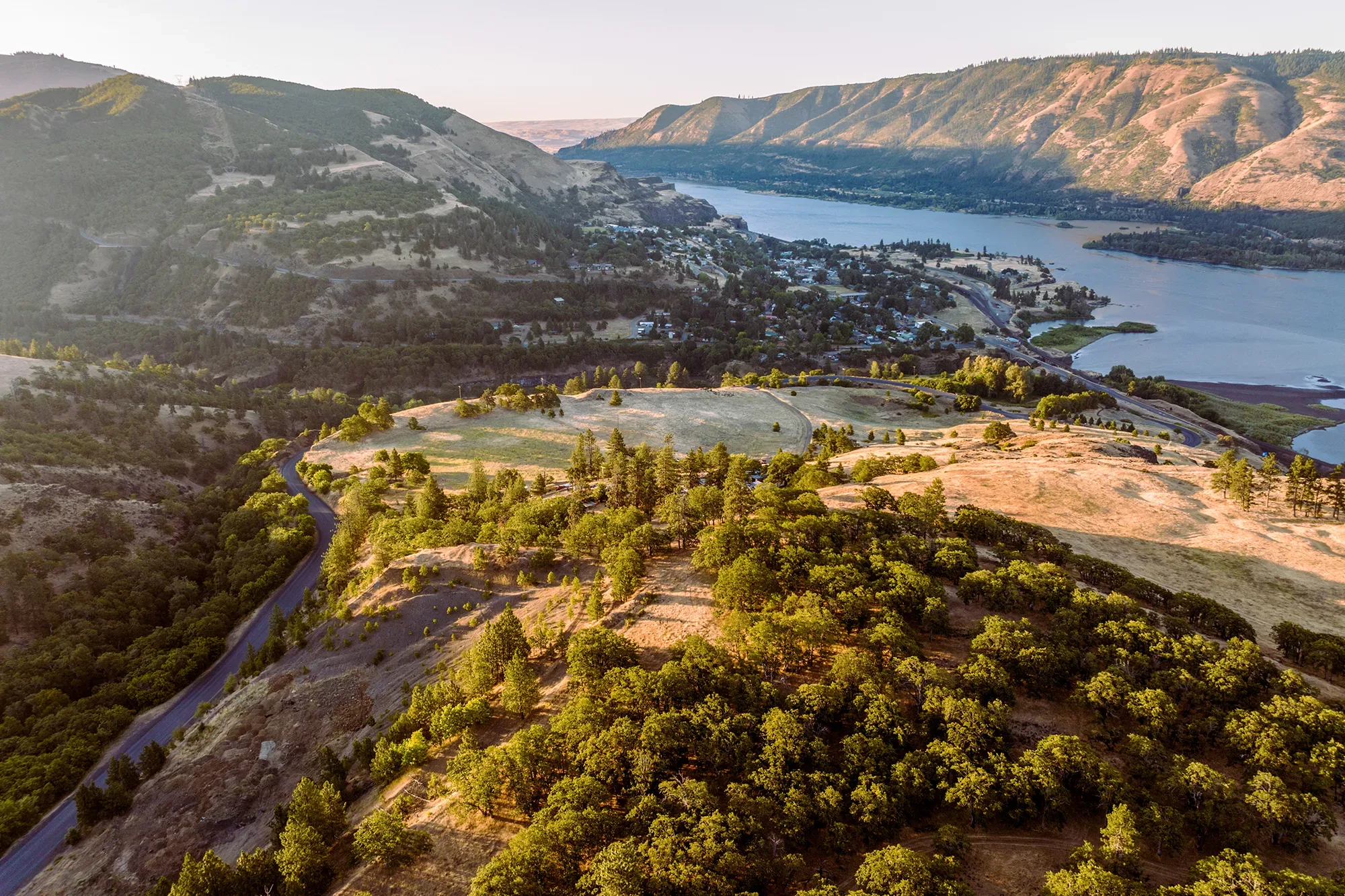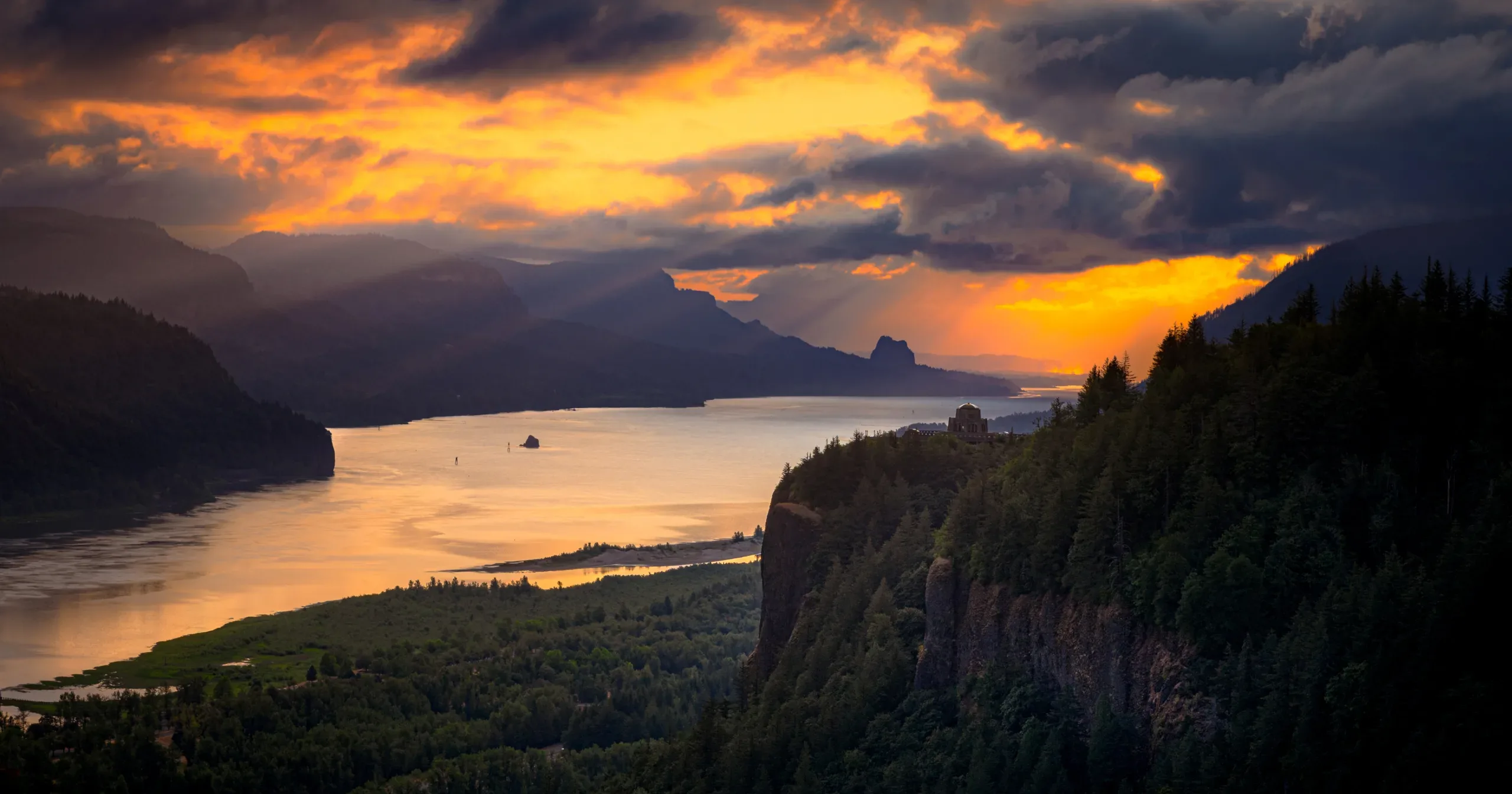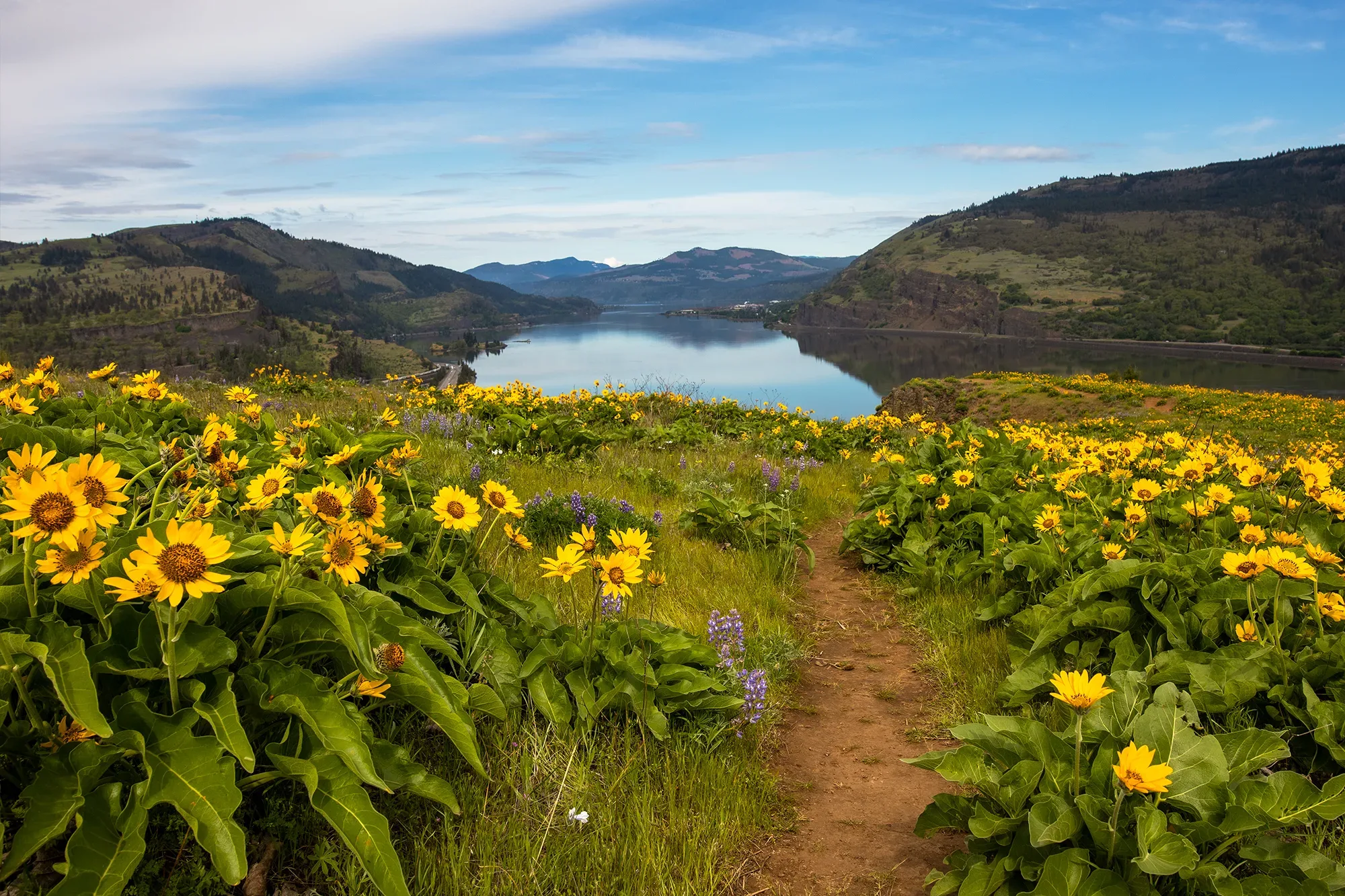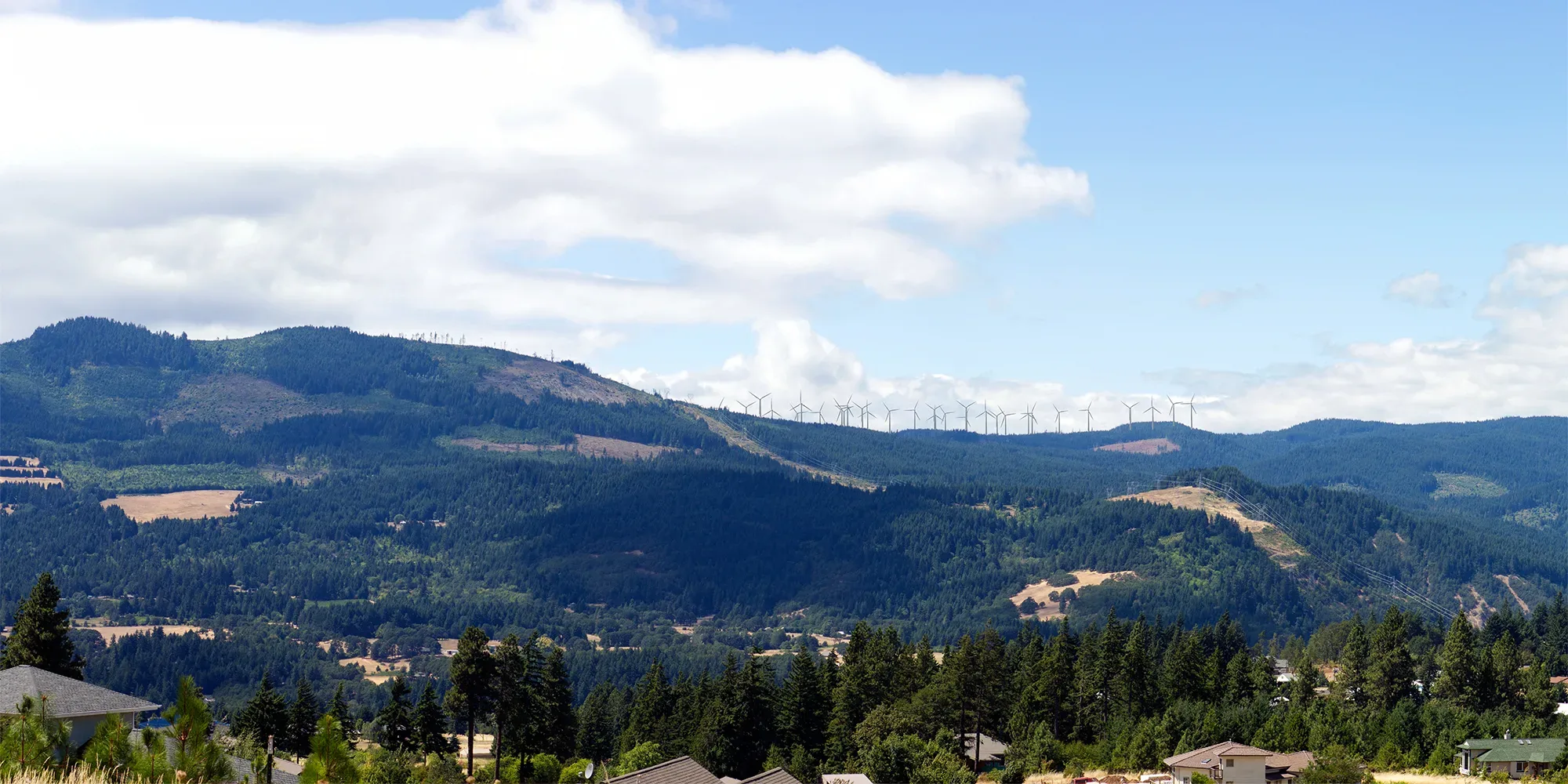Status update: 2024 – The state-issued permit for the project expired on March 5, 2022. In 2024, the Washington Energy Facility Site Evaluation Council (EFSEC) reviewed two separate requests, one that would have revived and extended the expired permit and another that would have transferred the permit and the project to a new parent company, Twin Creeks Timber (aka Green Diamond Resource Company). On July 17, 2024, EFSEC issued a written order denying both requests and declaring the permit “expired.”
Read “Victory for Conservation: Controversial Whistling Ridge Wind Project Ends After 22 Years” from our Summer/Fall 2024 magazine here.
Background
Proposed along the boundary of the National Scenic Area and within an area designated for the protection of the endangered northern spotted owl, the Whistling Ridge Energy Project would have marred world-class scenery and harmed endangered species habitat, with little to no benefit to the state of Washington’s citizens.
Icons of the Pacific Northwest, like the Columbia River Gorge, Mount Rainier, and the Olympic Mountains, should be off-limits to large-scale energy development. We can combat climate change without having to sacrifice our most special places and our core values.
Over the years, the proposed project went through several name changes and project reconfigurations. In 2002, PPM Energy. Inc. requested from the Bonneville Power Administration (BPA) a 70-MW generation interconnection to BPA’s energy grid for a new wind energy project, then called the “SDS Underwood Wind Generation Project.” In 2007, S.D.S. Co., LLC and Broughton Lumber Company proposed to build the renamed “Saddleback Wind Farm,” which would have consisted of up to 85 wind turbines, each up to 426 feet tall, on prominent ridgelines on both private and public land near the town of White Salmon.
In 2009, Whistling Ridge Energy, LLC (WRE) submitted an application to EFSEC for 50 turbines on private land under yet another new name, the “Whistling Ridge Energy Project.” Also in 2009, the Washington Department of Natural Resources rejected the request to build wind turbines on public land.
In 2012, state officials reduced the proposed Whistling Ridge Energy Project to no more than 35 wind turbines (down from the original proposal of 85 turbines), each up to 430 feet tall. At that point, the original project applicant, WRE announced that the project was on hold and “unlikely to move forward.” WRE never took any steps to move forward with the project. A permit issued for the project by Washington Governor Christine Gregoire expired ten years later, on March 5, 2022.
On September 13, 2023, more than a year and a half after the permit expired, requests were filed with EFSEC to resurrect the expired permit, create a new expiration date of November 1, 2026, and transfer the permit to a new owner. Ultimately, both requests were denied by the Council, and the permit was “declared expired” in a written order.
For more information, please visit EFSEC’s webpage for the Whistling Ridge Energy Project here.
Friends Opposes the Whistling Ridge Energy Project Because:
It would have harmed Columbia Gorge scenic resources.
The project site was located along the boundary of the Columbia River Gorge National Scenic Area in the heart of the Gorge. The immense turbines would have loomed over the Gorge horizon and would have been visible for many miles in every direction. The affected scenic landscape within the Cascade Mountain Range is visited by tourists from all over the world for its unique qualities, including dramatic mountain vistas, steep cliffs, pastoral lands, and the Columbia River.
It threatened protected wildlife.
The project would have also harmed wildlife by permanently removing thousands of acres of forested habitat, including land within a designated Northern Spotted Owl Special Emphasis Area. Furthermore, the site was never surveyed for birds during key migratory periods, in direct violation of state and federal rules for siting energy projects.
It would have harmed Gorge communities.
By diminishing Gorge scenic resources, the Whistling Ridge Energy Project would have harmed the local tourism economy and negatively affected property values in surrounding communities. It would have also caused substantial traffic and road damage along local roads during construction.
The project was not needed.
The average power capacity of the Whistling Ridge Energy Project would have been 25 megawatts or less, and the total capacity would ahve been 75 megawatts or less. This is a drop in the energy bucket compared to the more than 7,000 megawatts of installed wind power capacity in Washington and Oregon. BPA has concluded that wind power capacity “is being developed in the Northwest far in advance of regional power demand.” Because of this surplus, most Northwest wind energy is distributed to California. The Whistling Ridge project was simply not needed.
The public overwhelmingly opposed the project.
Eighty-six percent of public comments opposed or expressed concerns about the Whistling Ridge Energy Project. Concerns were raised by several public resource management agencies, tourism groups, and environmental organizations, including the National Park Service, the U.S. Forest Service, the Washington Department of Natural Resources, the Washington Counsel for the Environment, the Skamania County Agri-Tourism Association, Sustainable Travel International, Friends of the Historic Columbia River Highway, Seattle Audubon Society, Vancouver Audubon Society, Kittitas Audubon Society, Columbia Gorge Audubon Society, American Bird Conservancy, Conservation Northwest, and the Gifford Pinchot Task Force.
Friends of the Columbia Gorge supports responsible development of renewable energy sources, but the Whistling Ridge proposal was not responsible. It was not critical to our energy needs and was not worth sacrificing the unique scenic beauty and wildlife of the Columbia River Gorge.
Resources
- EFSEC Order deeming the Whistling Ridge Site Certification Agreement “expired”
- Whistling Ridge Energy’s project application
- Environmental Impact Statement for the Whistling Ridge proposal
- Visual simulation of the Whistling Ridge proposal
Media Links
- Tri-Cities activists plan to file lawsuit challenging approval of Horse Heaven Clean Energy Center, Northwest Public Broadcasting, Nov. 18, 2024
- News Analysis by Citizen Sandy: The SDS sale and its aftermath, The Goldendale Sentinel, Aug. 9, 2023
- Is Tri-Cities wind farm intrusive or a lifesaver? State wants to hear from you, Tri-City Herald, Mar. 29, 2021
- On wind turbine plan, WA Gov. Inslee should listen to Tri-Cities, Tri-City Herald, Mar. 19, 2021
- New SDS president says company will be sold, The Goldendale Sentinel, Dec. 30, 2020
- SDS value to county is far-ranging, The Goldendale Sentinel, Oct. 7, 2020
- SDS Lumber undergoing major shakeup, The Goldendale Sentinel, Sept. 30, 2020
- Counsel for the Environment influential in energy project siting, The Columbian, Mar. 21, 2016
- Review process has seen energy projects get derailed, The Columbian, Mar. 20, 2016
- Whistling Ridge faces new legal challenge, The Columbian, Sept. 18, 2015
- Groups appeal BPA’s approval of Whistling Ridge, Hood River News, Sept. 16, 2015
- Whistling Ridge Opponents Challenge BPA Interconnection ROD, Clearing Up, Sept. 11, 2015
- Groups challenge BPA approval to connect wind farm project, Asociated Press, Sept. 10, 2015
- State Supreme Court: Skamania County in violation of GMA, The Columbian, June 13, 2015
- Oil-terminal decision: How green is our governor?, The Columbian, Jan. 10, 2015
- Foes see partiality in oil terminal review process, The Columbian, Oct. 4, 2014
- Vancouver City Council eyes bigger role in oil terminal permit bid, The Columbian, Feb. 10, 2014
- Blowin’ in the Wind Upheld by Washington Supreme Court, Green Building Law Update, Oct. 4, 2013
- WA Supreme Court upholds state siting council’s approval of wind energy facility, Livability Law Blog, Sept. 26, 2013
- Another Voice: Whistling Ridge plan is unneeded nonstarter, Hood River News, Sept. 11, 2013
- Washington Court Ruling Keeps Spin On Whistling Ridge Windfarm Plan, Hood River News, Sept. 6, 2013
- Washington Supreme Court rejects challenge to Whistling Ridge wind Project, Energy Central, Sept. 4, 2013
- Court ‘sets precedent’ by approving Washington wind farm, Windpower Monthly, Sept. 3, 2013
- Court upholds Whistling Ridge wind project in Washington, Portland Business Journal, Sept. 3, 2013
- Washington Supreme Court won’t reverse decision on Whistling Ridge, Hood River News, Aug. 31, 2013
- State Supreme Court Upholds Whistling Ridge Project, Approval Process, Clearing Up, Aug. 30, 2013
- Court upholds Wash. approval of Gorge wind farm, KXLY, Aug. 29, 2013
- Court upholds state’s approval of Gorge wind farm, Associated Press, Aug. 29, 2013
- State Supreme Court rules in favor of wind farm, The Columbian, Aug. 28, 2013
- Washington Supreme Court hears wind farm case, Oregon Public Broadcasting, June 27, 2013
- Gorge wind-farm project headed for high court, The Columbian, May 1, 2013
- Wind power still in limbo despite renewed tax break, The Seattle Times, Jan. 20, 2013
- Supreme Court sets calendar for windpower project appeal, White Salmon Enterprise, Jan. 10, 2013
- Whistling Ridge Wind Farm Proposal Process Moves To Wash. Supreme Court, Hood River News, Nov. 27, 2012
- Gorge group sues Skamania on zoning issues, Portland Business Journal, Sept. 20, 2012
- Siting standards need not apply, WindAction, Apr. 29, 2012
- Wind power project approval appealed by two opponents, White Salmon Enterprise, Apr. 12, 2012
- Whistling Ridge decision contested, Hood River News, Apr. 7, 2012
- Advocacy groups challenge wind farm approval, The Columbian, Apr. 4, 2012
- Northwest view: Wind energy project near Gorge should be denied, The Columbian, Mar. 10, 2012
- Whistling ridge wind farm gets Gregoire’s go ahead, Hood River News, Mar. 7, 2012
- Whistling Ridge gets Governor’s OK, White Salmon Enterprise, Mar. 7, 2012
- Governor approves wind project, Skamania County Pioneer, Mar. 7, 2012
- Columbia Gorge wind farm opponents may go to court, Associated Press, Mar. 5, 2012
- Gov. Chris Gregoire approves Whistling Ridge wind farm outside Columbia River Gorge in Washington, but project on hold, The Oregonian, March 5, 2012
- Wind farm approved for north side of Columbia River Gorge, KING 5 News, Mar. 5, 2012
- Gregoire Approves Controversial Wind Facility, KNKX Public Radio, Mar. 5, 2012
- Columbia Gorge wind farm opponents may go to court, The Columbian, Mar. 4, 2012
- Wash. Governor approves Columbia Gorge wind farm, The Columbian, Mar. 4, 2012
- Governor approves Skamania County wind farm, Associated Press, Mar. 4, 2012
- Wind project with governor’s office, White Salmon Enterprise, Feb. 8, 2012
- Letter: Say no to wind farm in the Gorge, The Columbian, Jan. 25, 2012
- Letter: No to Whistling Ridge project, The Columbian, Jan. 10, 2012
- Whistling Ridge wind farm permit going to Governor, White Salmon Enterprise, Jan. 3, 2012
- Whistling ridge wind farm petitions denied, Hood River News, Dec. 31, 2011
- Washington council won’t revisit the approval of a wind farm visible from Columbia Gorge Scenic Area, The Oregonian, Dec. 28, 2011
- Panel reaffirms support of wind farm near Gorge, The Columbian, Dec. 28, 2011
- Wind farm friends, foes await governor’s decision, The Columbian, Dec. 27, 2011
- State panel to revisit Gorge wind farm proposal, The Columbian, Dec. 25, 2011
- Letter: Blighted views, The Oregonian, Dec. 10, 2011
- Letter: Look at turbines, The Dalles Chronicle, Dec. 6, 2011
- Letter: Turbines will blow away protection, The Columbian, Dec. 4, 2011
- Letter: Complaints of Whistling Ridge aired, The Columbian, Nov. 24, 2011
- Columbia Gorge: The Fight for Paradise, Oregon Field Guide, Nov. 17, 2011
- Letter: Wind energy is not good in Gorge, The Columbian, Nov. 15, 2011
- Groups want new decision on Whistling Ridge, Skamania County Pioneer, Nov. 2, 2011
- Letter: No to Whistling Ridge, Camas-Washougal Post-Record, Nov. 1, 2011
- Whistling Ridge foes file new objection, White Salmon Enterprise, Nov. 1, 2011
- Wind power project applicant seeks reconsideration; Opponents, too, White Salmon Enterprise, Nov. 1, 2011
- Letter: Turbine project sets bad precedent, Camas-Washougal Post-Record, Oct. 18, 2011
- Site council OKs wind project, White Salmon Enterprise, Oct. 11, 2011
- Council approves Whistling Ridge wind farm with limits, Hood River News, Oct. 8, 2011
- Controversial Whistling Ridge wind farm near Columbia River Gorge goes to Gregoire for approval, The Oregonian, Oct. 8, 2011
- Wind farm recommend near Columbia River Gorge, Associated Press, Oct. 6, 2011
- State panel backs Skamania wind project, The Columbian, Oct. 6, 2011
- Spotted owl advocates pipe up over Whistling Ridge wind farm proposal, The Columbian, Oct. 5, 2011
- Whistling Ridge wind farm, on edge of Columbia River Gorge National Scenic Area, up for vote today, The Oregonian, Oct. 5, 2011
- Letter: Oppose invasion of wind turbines, The Columbian, Sept. 28, 2011
- Whistling Ridge Project moves forward, White Salmon Enterprise, Sept. 13, 2011
- Wind Turbines Blow Away Gorge Views, Lensjoy.com, Lensjoy.com, July 2, 2011
- Scenery stealers: Wind farms ruin views in Columbia River Gorge, The Oregonian, July 2, 2011
- Letter: Turbines better suited elsewhere, The Columbian, May 13, 2011
- Letter: Wind energy project is poorly planned, The Columbian, May 10, 2011
- Better turbines may reduce scale of wind project, White Salmon Enterprise, Mar. 15, 2011
- Wind Project Near Columbia Gorge Scenic Area Awaits EFSEC Decision, Clearing Up, Feb. 7, 2011
- Underwood holds public meeting on wind project, White Salmon Enterprise, Dec. 21, 2010
- Washington’s wind power windfall, The Columbian, Oct. 10, 2010
- Let’s not spoil Gorge’s gorgeous views, The Columbian, Sept. 8, 2010
- New Landscapes Defined by Wind, Reading the Washington Landscape, July 30, 2010
- Bingen backs SDS wind energy proposal, White Salmon Enterprise, July 14, 2010
- Wind power backers, foes air views in Underwood, White Salmon Enterprise, June 22, 2010
- Solar salvation?, High Country News, Aug. 28, 2009
- DNR reconsiders SDS lease, White Salmon Enterprise, Aug. 25, 2009
- Spotted owls put wind farm on hold, The Everett Herald, Aug. 24, 2009
- State tables idea of wind farm lease in spotted owl habitat, The Columbian, Aug. 22, 2009
- Western Washington wind farm could threaten wildlife, state official says, Associated Press, June 8, 2009
- WA state biologist: wind project could pose risk, Seattle Post-Intelligencer, June 7, 2009
- Wind project will kill wildlife, biologist says, The Columbian, June 6, 2009
- Another Voice: Support well-planned energy development, Hood River News, June 6, 2009
- Advocate: In siting wind farm, don’t overlook the landscape, The Columbian, May 25, 2009
- Hearings outline issues for wind energy proposal, White Salmon Enterprise, May 19, 2009
- Wind Farm in the Forest, Gorge Living, Spring 2009
- ‘Whistling Ridge’ wind project filed with state, White Salmon Enterprise, Mar. 17, 2009
- SDS eyes expanded wind power project, White Salmon Enterprise, Feb. 17, 2009
- Wind Farm Project May Expand, The Columbian, Feb. 3, 2009
- : Wind power project good fit for Skamania, official says, The Columbian, Dec. 10, 2007
- Lumber company will apply to build Skamania wind farm, The Columbian, Sept. 5, 2007
Friends of the Columbia Gorge Articles
- Victory for Conservation: Controversial Whistling Ridge Wind Project Ends After 22 Years, Summer/Fall 2024
- Friends Challenges Whistling Ridge Project in Federal Court, Winter 2015
- Whistling Ridge Debate Continues, Winter 2013
- Friends Challenges Whistling Ridge Approval, Spring 2012
- Wind Energy Projects Threaten Gorge Resources, Spring 2011
Latest News

Celebrating the 20th Anniversary of Friends’ Land Trust

2025 Legislative Sessions: Wins and Challenges in Oregon and Washington



